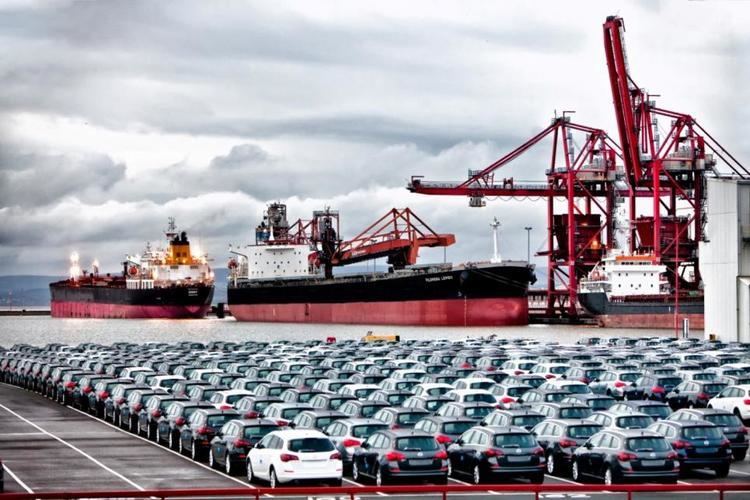 | ||
Mv arklow bay port of bristol avonmouth 10 04 16
The Port of Bristol comprises the commercial, and former commercial, docks situated in and near the city of Bristol in England. The Port of Bristol Authority was the commercial title of the Bristol City, Avonmouth, Portishead and Royal Portbury Docks when they were operated by Bristol City Council, which ceased trade when the Avonmouth and Royal Portbury Docks were leased to The Bristol Port Company in 1991.
Contents
History
For more information on the history of the different dock complexes, see Bristol Harbour, Avonmouth Docks, Portishead and Royal Portbury Dock.
The Port of Bristol grew up on the banks of the Rivers Avon and Frome, at their confluence upstream of the Avon Gorge which connects the city with the Bristol Channel. This part of the port was known as the Bristol City Docks, and is now more usually known as Bristol Harbour. The Avon and Frome are small, shallow rivers incapable in themselves of accommodating ocean-going ships, even those of the age of sail, as can still be seen by inspecting the branch of the Avon known as the New Cut at low tide. The harbour depended on the extreme tides (14 metres) experienced in the Bristol Channel. Ships that wished to enter the harbour waited for the tide to begin to rise and floated up the river, through the Avon Gorge, and into the harbour on the tide. Ships leaving the harbour set out at the high tide, and floated down to the sea with the ebbing tide. In the 1800s the harbour was enclosed by locks, together with a diversion of the River Avon, resulting in its alternative name of the Floating Harbour, taken from the fact that the ships were able to float at all times, rather than resting in the mud at low tide, as had previously been the case.
Shipping Masters appointed under the Merchant Shipping Act included Henry Hellier Peters.
The navigation of the Avon Gorge always presented a challenge, and became more and more difficult as ships got larger. In 1877, Avonmouth Old Dock, the first of the Avonmouth Docks, was opened, and in 1884 the Bristol Corporation acquired both the Avonmouth and Portishead Docks. In 1908 the Royal Edward Dock was built at Avonmouth to the north of the mouth of the River Avon and with direct access to the Severn estuary and Bristol Channel.
In 1972 the large deep water Royal Portbury Dock, across the river mouth from the Royal Edward Dock was constructed, again with direct access to the Bristol Channel.
These developments rendered the old Bristol City Docks in the Floating Harbour redundant as a commercial dock, and they have since been redeveloped as the centrepiece of many leisure, residential and retail developments in and around Bristol city centre. A sand company was the last to use the docks commercially in 1991.
The closure of the power stations at Portishead also made the Portishead Dock redundant, and it was finally closed in 1992.
In 1991 The Bristol Port Company, a private company, owned by Terence Mordaunt and David Ord, purchased a 150-year lease of the Avonmouth and Royal Portbury Docks from Bristol City Council. Since then over £550m has been invested in the docks and the annual tonnage throughput has increased from 4m tonnes to 12m tonnes. In 2014 the council sold the freehold of the port to the company for £10 million, but retained a 12.5% non voting stake in the company.
Archives
Bristol Archives holds material related to the port of Bristol from the 13th century onwards. Records of the Port of Bristol Authority are also held at Bristol Archives (Ref. PBA) (online catalogue).
Further records are held by the Institution of Civil Engineers.
New container terminal
A new deepsea container terminal is planned in Avonmouth.
